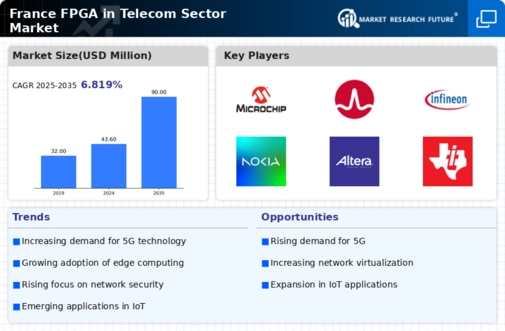Emergence of IoT Applications
The rapid emergence of Internet of Things (IoT) applications in France is driving the growth of the fpga in-telecom-sector market. As IoT devices proliferate, the need for efficient data processing and transmission becomes paramount. FPGAs are well-suited for handling the diverse requirements of IoT applications, offering the necessary adaptability and performance. The number of connected IoT devices in France is projected to reach 1 billion by 2026, creating a substantial demand for telecom infrastructure capable of supporting these devices. This trend suggests that FPGAs will play a pivotal role in enabling seamless communication between IoT devices and telecom networks, thereby enhancing overall system efficiency and reliability.
Increased Focus on Cybersecurity
The heightened focus on cybersecurity within the telecom sector is driving demand for advanced solutions, including FPGAs. As cyber threats become more sophisticated, telecom operators in France are compelled to enhance their security measures. FPGAs offer unique advantages in implementing security protocols and encryption, making them an attractive option for telecom companies. The market for cybersecurity solutions in the telecom sector is projected to grow by 25% over the next five years, indicating a strong potential for FPGA integration. This trend underscores the importance of FPGAs in safeguarding telecom networks against emerging threats, thereby ensuring the integrity and reliability of communication services.
Government Initiatives and Funding
Government initiatives aimed at enhancing telecommunications infrastructure in France significantly impact the fpga in-telecom-sector market. The French government has launched several programs to promote digital transformation, including substantial funding for telecom upgrades. These initiatives are designed to improve connectivity in rural areas and urban centers alike, thereby increasing the demand for advanced technologies such as FPGAs. Recent reports indicate that the government has allocated over €1 billion towards improving broadband access, which is likely to stimulate the adoption of FPGA solutions in the telecom sector. This financial support not only encourages innovation but also positions FPGAs as a critical component in the modernization of France's telecommunications landscape.
Shift Towards Network Virtualization
The shift towards network virtualization in the telecom sector is another significant driver for the fpga in-telecom-sector market. As telecom operators in France increasingly adopt software-defined networking (SDN) and network functions virtualization (NFV), the need for flexible and high-performance hardware solutions becomes critical. FPGAs provide the necessary capabilities to support these technologies, allowing for dynamic resource allocation and improved network management. This transition is expected to enhance operational efficiency and reduce costs for telecom operators. Market analysis indicates that the adoption of SDN and NFV is likely to grow by 20% annually in France, further solidifying the role of FPGAs in modern telecom infrastructure.
Rising Demand for High-Speed Connectivity
The increasing demand for high-speed connectivity in France is a primary driver for the fpga in-telecom-sector market. As consumers and businesses alike seek faster internet services, telecom operators are compelled to upgrade their infrastructure. This shift necessitates the deployment of advanced technologies, including FPGAs, which offer the flexibility and performance required for high-speed data transmission. According to recent data, the demand for broadband services in France has surged, with a reported growth rate of 15% in the last year alone. This trend indicates a robust market opportunity for FPGA solutions, as they can be tailored to meet the specific needs of telecom operators, enhancing their service offerings and customer satisfaction.






















Leave a Comment